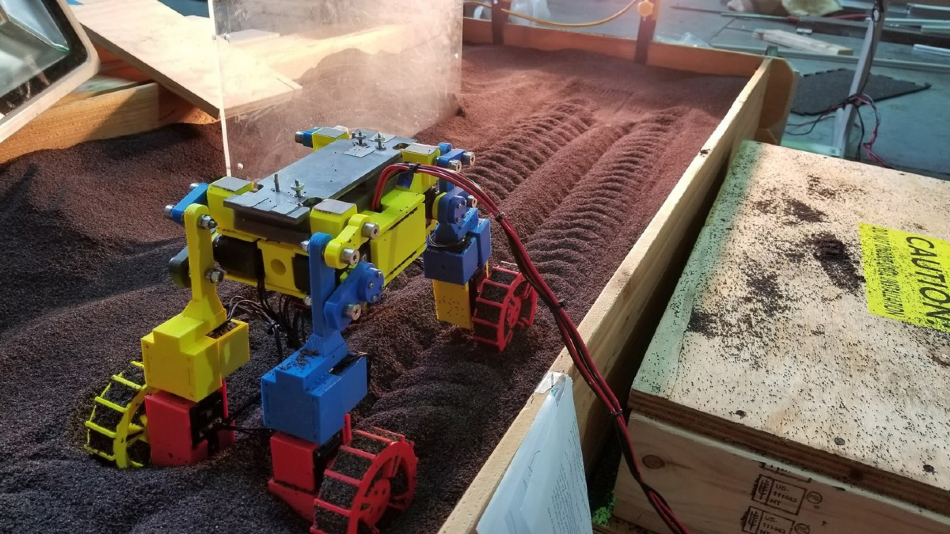May 15 2020
A new robot created with funding from the U.S. Army features intricate locomotion techniques powerful enough to enable it to climb sand-covered hills without getting stuck. The robot has been developed with wheeled appendages that can be lifted.
 The Mini Rover moves through a bed of poppy seeds designed to model movement through granular surfaces. The robot was used to test complex locomotion techniques robust enough to help it climb planetary or lunar hills covered with such granular material. Image Credit: Goldman lab, Georgia Tech.
The Mini Rover moves through a bed of poppy seeds designed to model movement through granular surfaces. The robot was used to test complex locomotion techniques robust enough to help it climb planetary or lunar hills covered with such granular material. Image Credit: Goldman lab, Georgia Tech.
NASA has expressed its interest in the robot for the potential survey of the Moon or a planet.
Dubbed Mini Rover, the robot uses a move that scientists at Georgia Institute of Technology named rear rotator pedaling to climb a slope by leveraging a design that integrates walking, paddling, and wheel-spinning motions. The behaviors of the rover were modeled using terradynamics, a branch of physics.
The study was published in the Science Robotics journal as a cover article. The research was funded by the Army Research Office, an element of the U.S. Army Combat Capabilities Development Command’s Army Research Laboratory and NASA, through the National Robotics Initiative.
This basic research is revealing exciting new approaches for locomotion in complex terrain. This could lead to platforms capable of intelligently transitioning between wheeled and legged modes of movement to maintain high operational tempo.
Dr Samuel Stanton, Program Manager, ARO
The researchers stated that the flow of loose materials like sand can create problems for robots that move over it.
According to Dan Goldman, the Dunn Family Professor in the School of Physics at the Georgia Institute of Technology, “This rover has enough degrees of freedom that it can get out of jams pretty effectively. By avalanching materials from the front wheels, it creates a localized fluid hill for the back wheels that is not as steep as the real slope. The rover is always self-generating and self-organizing a good hill for itself.”
A robot developed at NASA’s Johnson Space Center pioneered the potential to spin its wheels, use the wheels to sweep the surface, and lift each of its wheeled appendages wherever necessary, thus forming a wide range of potential motions.
The Georgia Tech researchers joined hands with the Johnson Space Center and used in-house 3D printers to rebuild those potentials in a scaled-down vehicle including four-wheeled appendages powered by 12 different motors.
The rover was developed with a modular mechatronic architecture, commercially available components, and a minimal number of parts. This enabled our team to use our robot as a robust laboratory tool and focus our efforts on exploring creative and interesting experiments without worrying about damaging the rover, service downtime, or hitting performance limitations.
Siddharth Shrivastava, Undergraduate Student, George W. Woodruff School of Mechanical Engineering, Georgia Institute of Technology
The extensive range of movements exhibited by the rover enabled the researchers to test several variations that were analyzed using modified Resistive Force Theory and granular drag force measurements. They started with the gaits investigated by the NASA RP15 robot and performed experiments using the locomotion schemes that were impossible to be tested on a full-size rover.
In addition, they tested their experimental gaits on slopes created to mimic lunar and planetary hills with the help of a fluidized bed system called SCATTER—Systematic Creation of Arbitrary Terrain and Testing of Exploratory Robots—that could be tilted to assess the role of controlling the granular substrate.
During the experiments, the new gait enabled the rover to climb a steep slope, where the front wheels stirred up the granular material—which was poppy seeds for the lab testing—and pushed them back toward the rear wheels.
Wiggling from side-to-side, the rear wheels lifted and spun to develop a motion that mimicked paddling in water. The material pushed toward the back wheels usefully altered the slope to be climbed by the rear wheels, thus enabling the rover to achieve steady progress up a hill, which could not be achieved by a simple wheeled robot.
In our previous studies of pure legged robots, modeled on animals, we had kind of figured out that the secret was to not make a mess. If you end up making too much of a mess with most robots, you end up just paddling and digging into the granular material. If you want fast locomotion, we found that you should try to keep the material as solid as possible by tweaking the parameters of motion.
Dan Goldman, Dunn Family Professor, School of Physics, Georgia Institute of Technology
However, simple motions had been challenging for Mars rovers, which got stuck in granular materials. According to Goldman, this gait discovery could help future rovers prevent that fate.
“This combination of lifting and wheeling and paddling, if used properly, provides the ability to maintain some forward progress even if it is slow. Through our laboratory experiments, we have shown principles that could lead to improved robustness in planetary exploration—and even in challenging surfaces on our own planet,” added Goldman.
In the future, the researchers intend to scale up the new experimental gaits to larger robots, and to investigate the concept of analyzing robots and their localized environments in unison.
The Mini Rover was mainly developed to analyze planetary and lunar exploration, but the experience gained could be applied to terrestrial locomotion—an area of interest to the Army.
Journal Reference:
Shrivastava, S., et al. (2020) Material remodeling and unconventional gaits facilitate locomotion of a robophysical rover over granular terrain. Science Robotics. doi.org/10.1126/scirobotics.aba3499.